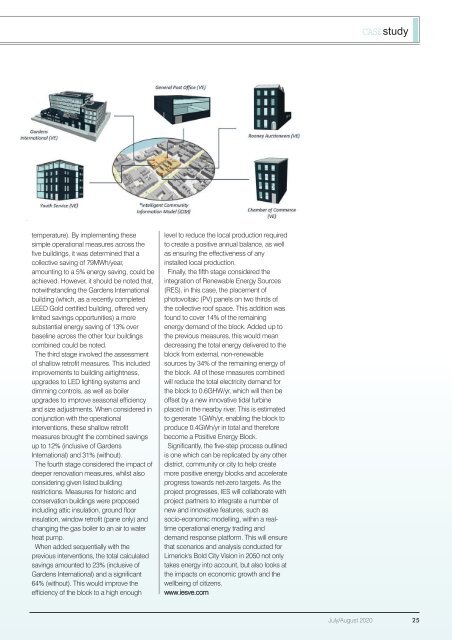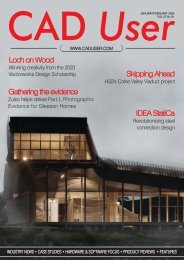Create successful ePaper yourself
Turn your PDF publications into a flip-book with our unique Google optimized e-Paper software.
CASE study<br />
temperature). By implementing these<br />
simple operational measures across the<br />
five buildings, it was determined that a<br />
collective saving of 79MWh/year,<br />
amounting to a 5% energy saving, could be<br />
achieved. However, it should be noted that,<br />
notwithstanding the Gardens International<br />
building (which, as a recently completed<br />
LEED Gold certified building, offered very<br />
limited savings opportunities) a more<br />
substantial energy saving of 13% over<br />
baseline across the other four buildings<br />
combined could be noted.<br />
The third stage involved the assessment<br />
of shallow retrofit measures. This included<br />
improvements to building airtightness,<br />
upgrades to LED lighting systems and<br />
dimming controls, as well as boiler<br />
upgrades to improve seasonal efficiency<br />
and size adjustments. When considered in<br />
conjunction with the operational<br />
interventions, these shallow retrofit<br />
measures brought the combined savings<br />
up to 12% (inclusive of Gardens<br />
International) and 31% (without).<br />
The fourth stage considered the impact of<br />
deeper renovation measures, whilst also<br />
considering given listed building<br />
restrictions. Measures for historic and<br />
conservation buildings were proposed<br />
including attic insulation, ground floor<br />
insulation, window retrofit (pane only) and<br />
changing the gas boiler to an air to water<br />
heat pump.<br />
When added sequentially with the<br />
previous interventions, the total calculated<br />
savings amounted to 23% (inclusive of<br />
Gardens International) and a significant<br />
64% (without). This would improve the<br />
efficiency of the block to a high enough<br />
level to reduce the local production required<br />
to create a positive annual balance, as well<br />
as ensuring the effectiveness of any<br />
installed local production.<br />
Finally, the fifth stage considered the<br />
integration of Renewable Energy Sources<br />
(RES), in this case, the placement of<br />
photovoltaic (PV) panels on two thirds of<br />
the collective roof space. This addition was<br />
found to cover 14% of the remaining<br />
energy demand of the block. Added up to<br />
the previous measures, this would mean<br />
decreasing the total energy delivered to the<br />
block from external, non-renewable<br />
sources by 34% of the remaining energy of<br />
the block. All of these measures combined<br />
will reduce the total electricity demand for<br />
the block to 0.6GHW/yr, which will then be<br />
offset by a new innovative tidal turbine<br />
placed in the nearby river. This is estimated<br />
to generate 1GWh/yr, enabling the block to<br />
produce 0.4GWh/yr in total and therefore<br />
become a Positive Energy Block.<br />
Significantly, the five-step process outlined<br />
is one which can be replicated by any other<br />
district, community or city to help create<br />
more positive energy blocks and accelerate<br />
progress towards net-zero targets. As the<br />
project progresses, IES will collaborate with<br />
project partners to integrate a number of<br />
new and innovative features, such as<br />
socio-economic modelling, within a realtime<br />
operational energy trading and<br />
demand response platform. This will ensure<br />
that scenarios and analysis conducted for<br />
Limerick's Bold City Vision in 2050 not only<br />
takes energy into account, but also looks at<br />
the impacts on economic growth and the<br />
wellbeing of citizens.<br />
www.iesve.com<br />
<strong>Jul</strong>y/<strong>Aug</strong>ust <strong>2020</strong> 25

















